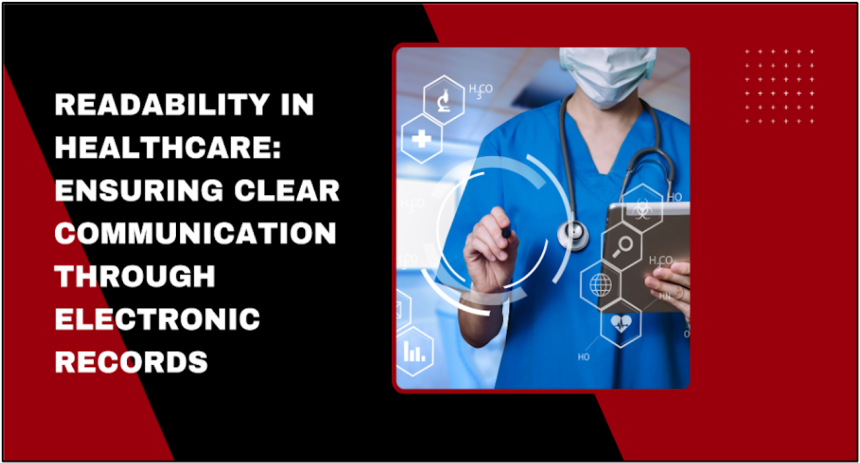Healthcare facilities are embracing electronic health records (EHRs) to enhance patient care efficiency and boost communication between healthcare staff. Yet guaranteeing the clarity of these records is vital for effective communication and positive patient results. Healthcare professionals often grapple with navigating and making sense of data in EHRs. This article addresses common concerns faced by healthcare professionals. Offer key insights and frequently asked questions to help you grasp why readability matters in healthcare and how to ensure transparent communication, through electronic records.
The Importance of Readability in Healthcare
Maintaining clear and concise documentation in electronic health records is essential for ensuring patient safety and delivering high-quality care. Quick and accurate interpretation of patient information equips healthcare providers to make informed decisions, reduce errors, and provide timely interventions. Readability plays a vital role in facilitating this process by ensuring that the information presented is easily comprehensible and free from ambiguity.
Efficiency and Time Management
In the fast-paced healthcare environment, time is a precious resource. Healthcare professionals often juggle multiple patients and tasks simultaneously, making it crucial for them to access and understand patient information efficiently. When electronic health records are designed with readability in mind, healthcare providers can quickly locate and process relevant information, saving valuable time and allowing them to focus on delivering care to their patients.
Collaborative Care and Communication
Effective communication among healthcare team members is essential for providing coordinated and comprehensive patient care. Electronic health records serve as a central repository for patient information, facilitating collaboration and information sharing among healthcare providers. By ensuring that the information within these records is highly readable, healthcare professionals can communicate more effectively, reducing the risk of misinterpretation and promoting a seamless continuum of care.
Difference between EHR and EMR
When it comes to digital record-keeping in healthcare, two terms often come up, Electronic Health Records (EHR) and Electronic Medical Records (EMR). While these terms are sometimes used interchangeably, there are notable differences between the two. If you’ve ever wondered, “what is the difference between EHR and EMR?” you’re not alone. The table below provides a comprehensive comparison of EHR and EMR systems, highlighting their key features and distinctions.
| Feature | Electronic Health Record (EHR) | Electronic Medical Record (EMR) |
| Scope | Comprehensive patient records across multiple healthcare providers and settings | Single healthcare provider or organization |
| Data Sharing | Enables secure sharing of patient information among authorized healthcare providers | Limited data sharing, primarily within a single healthcare organization |
| Interoperability | Designed to be interoperable, allowing data exchange between different EHR systems | May have limited interoperability with other systems |
| Patient Access | Provides patients with secure access to their health information through patient portals | Patient access to medical records may be limited or unavailable |
| Decision Support | Includes advanced decision support tools, such as clinical guidelines and alert systems | Basic decision support capabilities focused on a single organization’s needs |
| Population Health | Supports population health management and public health initiatives through data aggregation and analysis | Limited ability to support population health initiatives due to a narrower scope of data |
| Functionality | Offers a wide range of functionalities, including e-prescribing, order entry, and care coordination tools | Focuses primarily on digital documentation and storage of medical records within a single organization |
| Certification | Certified by recognized organizations to meet specific standards for functionality, interoperability, and security | Certification is not required, and standards may vary among EMR systems |
Strategies for Enhancing Readability in Electronic Health Records
Standardized Terminology and Abbreviations
One of the key challenges in healthcare communication is the use of complex medical terminology and abbreviations. To improve readability, it is essential to establish standardized terminology and abbreviations within electronic health records. By using a consistent and widely accepted set of terms and abbreviations, healthcare providers can minimize confusion and ensure that information is accurately interpreted across different settings and disciplines.
Structured and Organized Documentation
Structuring and organizing patient information in a logical and intuitive manner can significantly enhance readability. Electronic health records should be designed with clear sections and headings, making it easy for healthcare providers to locate specific information quickly. By using standardized templates and prompts, healthcare professionals can ensure that critical information is captured consistently and comprehensively, reducing the likelihood of missing or incomplete data.
Clear and Concise Language
Using clear and concise language is crucial for effective communication in healthcare. When documenting patient information in electronic health records, healthcare providers should aim to use plain language whenever possible, avoiding jargon and complex sentence structures. By presenting information in a straightforward and easily understandable manner, healthcare professionals can facilitate better comprehension and reduce the risk of misinterpretation.
Visual Aids and Formatting
Incorporating visual aids and effective formatting techniques can greatly enhance the readability of electronic health records. The use of bullet points, tables, and graphs can help break down complex information into more digestible chunks, making it easier for healthcare providers to quickly grasp key points. Additionally, using appropriate font sizes, colors, and spacing can improve the visual appeal and legibility of the information presented.
User-Centered Design and Testing
To ensure that electronic health records are truly readable and user-friendly, it is essential to involve healthcare professionals in the design and testing process. By gathering feedback and insights from end-users, healthcare organizations can identify areas where readability can be improved and make necessary adjustments. Regular usability testing and iterative improvements can help ensure that electronic health records are optimized for readability and meet the needs of healthcare providers.
The Role of Training and Education
Training and education are crucial for promoting good documentation in electronic health records. Healthcare organizations should offer continuous training to professionals on using EHRs effectively, stressing clear and concise documentation. This equips providers with skills to ensure patient information is clearly communicated. Healthcare organizations need feedback from professionals to improve electronic health records. Providers should offer ideas to enhance EHRs. Organizations must listen and act on feedback for better readability.
Frequently Asked Questions
1. How do electronic health records improve communication?
Electronic health records (EHRs) improve communication by providing a centralized repository for patient information, enabling real-time updates and secure data sharing among authorized healthcare providers. EHRs promote standardized documentation practices, reducing ambiguity and ensuring consistency in communication, thus facilitating collaborative care and seamless information exchange.
2. How do you ensure clear communication?
To ensure clear communication, use plain language, avoiding jargon and complex medical terminology when possible. Organize your messages in a logical and structured manner, provide relevant context, and proofread for clarity and accuracy. Encourage feedback and open communication to address any questions or concerns.
3. What are electronic ways of communicating?
Electronic ways of communicating in healthcare include electronic health records (EHRs), secure messaging within EHR systems, secure email, video conferencing for telemedicine and collaboration, and patient portals for patient-provider communication and access to health information.
4. What should you do when communicating electronically?
When communicating electronically in healthcare, maintain confidentiality by adhering to privacy and security regulations, verify recipients to prevent unauthorized access, use secure and encrypted platforms approved by your organization, maintain a professional tone, and provide timely responses to ensure continuity of care.
Conclusion
Prioritizing readability in electronic health records is essential for healthcare professionals to ensure clear communication and provide the best possible care to their patients. By implementing strategies such as standardized terminology, structured documentation, clear language, visual aids, and user-centered design, you can significantly enhance the readability of EHRs.
Remember that ongoing training and education are crucial for promoting good documentation practices and staying up-to-date with the latest best practices in EHR readability. By prioritizing readability, you can harness the full potential of electronic health records, leading to improved efficiency, better collaboration, and ultimately, better patient outcomes.
Lynn Martelli is an editor at Readability. She received her MFA in Creative Writing from Antioch University and has worked as an editor for over 10 years. Lynn has edited a wide variety of books, including fiction, non-fiction, memoirs, and more. In her free time, Lynn enjoys reading, writing, and spending time with her family and friends.















